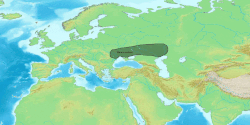Proto-Indo-Aryan language
| Proto-Indo-Aryan | |
|---|---|
| PIA, Proto-Indic | |
| Reconstruction of | Indo-Aryan languages |
Reconstructed ancestors | |
| Part of a series on |
| Indo-European topics |
|---|
 |
| |
Proto-Indo-Aryan (sometimes Proto-Indic[note 1]) is the reconstructed proto-language of the Indo-Aryan languages.[1] It is intended to reconstruct the language of the Indo-Aryans, who had migrated into the Indian subcontinent. Being descended from Proto-Indo-Iranian (which in turn is descended from Proto-Indo-European),[2] it has the characteristics of a satem language.[3]
History
[edit]Proto-Indo-Aryan is meant to be the predecessor of Old Indo-Aryan (1500–300 BCE), which is directly attested as Vedic and Classical Sanskrit, as well as by the Indo-Aryan superstrate in Mitanni. Indeed, Vedic Sanskrit is very close to Proto-Indo-Aryan.[4]
Some of the Prakrits display a few minor features derived from Proto-Indo-Aryan that had already disappeared in Vedic Sanskrit.
Today, numerous modern Indo-Aryan languages are extant.
Differences from Vedic
[edit]Despite the great archaicity of Vedic, the other Indo-Aryan languages preserve a small number of conservative features lost in Vedic.[5]
One of these is the representation of Proto-Indo-European *l and *r. Vedic (as also most Iranic languages) merges both as /r/. Later, however, some instances of Indo-European /l/ again surface in Classical Sanskrit, indicating that the contrast survived in an early Indo-Aryan dialect parallel to Vedic. (A dialect with only /l/ is additionally posited to underlie Magadhi Prakrit.)[6] However, it is not clear that the contrast actually survived anywhere in Indo-Iranian, not even in Proto-Indo-Iranian, as /l/ is also found in place of original *r in Indo-Iranian languages.
The common consonant cluster kṣ /kʂ/ of Vedic and later Sanskrit has a particularly wide range of Proto-Indo-European (PIE) and Proto-Indo-Iranian (PII) sources, which partly remain distinct in later Indo-Aryan languages:[7]
- PIE *ks, *kʷs, *gs, *gʷs > PII *kš > Middle Indo-Aryan kh-, -kkh-
- PIE *dʰgʷʰ, *gʰs, *gʷʰs > PII *gʱžʱ > Middle Indo-Aryan gh-, -ggh-
- PIE *tḱ; *ǵs, *ḱs > PII *tć, *ćš > Middle Indo-Aryan ch-, -cch-
- PIE *dʰǵʰ, *ǵʰs > PII *ȷ́ʱžʱ > Middle Indo-Aryan jh-, -jh-
Personal pronouns (nominative case)
[edit]Most personal pronouns are identical between Proto-Indo-Iranian and Proto-Indo-Aryan and show modest differences between Proto-Indo-Aryan and Sanskrit
| Pronoun | PIE | PII and PIA |
|---|---|---|
| I | *éǵ > *eǵHóm | *aȷ́Hám > *aȷ́ʰám > PIA *aźʰám > Skr अहम् (ahám) |
| You | *túh₂ | *túH > PIA *tuHám > Skr त्वम् (tvám) |
| He | *ey- (*eyóm?) *só | *sá |
| She | *séh₂ | *sáH > Skr सा (sā́) |
| It | *tód | *tád > Skr तद् (tad) |
| We | *wéy > *weyóm | *wayám |
| You (all) | *yū́ | *yúH > Skr यूयम् (yūyám) |
| They (m.) | *tóy | *táy > Skr ते (te) /tai/ |
| They (f.) | *téh₂es | *tā́s (or *táHas?) > Skr ताः (tāḥ) |
| They (n.) | *téh₂ | *tá > Skr तानि (tāni) |
Numerals
[edit]Most numerals are identical between Proto-Indo-Iranian and Proto-Indo-Aryan. Most number show minimal differences between Proto-Indo-Aryan and Sanskrit (e.g., the loss of the fricative sound *H).
| Numeral | PIE | PII and PIA |
|---|---|---|
| One (1) | *h₁óynos > *h₁óykos | *Háykas > Skr एक (éka) /aika/ |
| Two (2) | *dwóh₁ | *dwáH > Skr द्व (dvá) |
| Three (3) | *tréyes | *tráyas > Skr त्रयः (tráyaḥ) [nom. plur.] |
| Four (4) | *kʷetwóres | *čatwā́ras > Skr चत्वारः (catvā́raḥ) [nom.] |
| Five (5) | *pénkʷe | *pánča |
| Six (6) | *swéḱs | *šwáćš > PIA *ṣwáṭṣ > Skr षट् (ṣáṭ) |
| Seven (7) | *septḿ̥ | *saptá |
| Eight (8) | *oḱtṓw | *Haštā́ > PIA *Haṣṭā́ > Skr अष्ट (aṣṭá) |
| Nine (9) | *h₁néwn̥ | *Hnáwa > Skr नव (náva) |
| Ten (10) | *déḱm̥ | *dáća > PIA *dáśa |
Notes
[edit]- ^ In modern and colloquial context, the term "Indic" refers more generally to the languages of the Indian subcontinent, thus also including non-Aryan languages like Dravidian and Munda. See e.g. Reynolds, Mike; Verma, Mahendra (2007). "Indic languages". In Britain, David (ed.). Language in the British Isles. Cambridge: Cambridge University Press. pp. 293–307. ISBN 978-0-521-79488-6. Retrieved 2021-10-04.
References
[edit]- ^ Cardona, George; Jain, Dhanesh (26 July 2007). The Indo-Aryan Languages. Routledge. ISBN 9781135797119. Retrieved 24 October 2015.
- ^ "ARYANS – Encyclopedia Iranica". Encyclopedia Iranica. Retrieved 23 October 2015.
- ^ Wheeler, L. Kip. "The Indo-European Family of Languages". Dr. Wheeler's Website. Retrieved 12 November 2015.
- ^ see e.g. Radhakrishnan & Moore 1957, p. 3; Witzel, Michael, "Vedas and Upaniṣads", in: Flood 2003, p. 68; MacDonell 2004, pp. 29–39; Sanskrit literature (2003) in Philip's Encyclopedia. Accessed 2007-08-09
- ^ Masica, Colin P. (1991). The Indo-Aryan Languages. p. 156.
- ^ Masica, Colin P. (1991). The Indo-Aryan Languages. p. 97.
- ^ Kobayashi, Masato (2004). Historical Phonology of Old Indo-Aryan Consonants. Study of Languages and Cultures of Asia and Africa Monograph Series. Vol. 42. pp. 60–65. ISBN 4-87297-894-3.
Works cited
[edit]- Flood, Gavin, ed. (2003). The Blackwell companion to Hinduism. Oxford: Blackwell Publ. ISBN 1-4051-3251-5.
- MacDonell, Arthur Anthony (2004). A Practical Sanskrit Dictionary. Motilal Banarsidass. ISBN 978-81-208-2000-5.
- Radhakrishnan, S.; Moore, C. A. (1957). A Source Book in Indian Philosophy. Princeton, New Jersey: Princeton University Press. ISBN 978-0-691-01958-1.
{{cite book}}: ISBN / Date incompatibility (help)
Further reading
[edit]- Morgenstierne, Georg. "Early Iranic Influence upon Indo-Aryan." Acta Iranica, I. série, Commemoration Cyrus. Vol. I. Hommage universel (1974): 271–279.


 French
French Deutsch
Deutsch